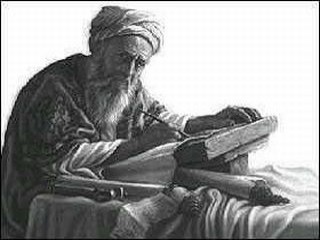
Abu Rayhan Al-Biruni biography
Date of birth : -
Date of death : -
Birthplace : Kath, Khwarazm, Samanid Persia
Nationality : Persian
Category : Science and Technology
Last modified : 2010-11-06
Credited as : Mathematician and astronomer, geographer and historian,
Abu Rayhan al-Biruni (973-ca. 1050), a Moslem astronomer, mathematician, geographer, and historian, was the most acute interpreter of India to Islam in the Middle Ages.
Al-Biruni was born near Kath in Khwarizm (now a part of Uzbekistan) on Sept. 4, 973. His teacher in astronomy and mathematics was the eminent Abu Nasr Mansur, a member of the family then ruling at Kath. Al-Biruni made several observations with a meridian ring at Kath in his youth. In 995 the attack on the ruler of Khwarizm by the ruler of Jurjaniya drove al-Biruni into exile, presumably to Rayy, where he discussed with the astronomer al-Khujandi the latter's observations with a mural sextant. AlBiruni later wrote a treatise on this instrument and gave a detailed account of the observations in his Tahdid.
In 997 al-Biruni returned to Kath, where he observed a lunar eclipse that Abu al-Wafa observed in Baghdad; on the basis of the time difference they determined the longitudinal difference between the two cities, one of the few instances in which this method, the only secure one available in antiquity, is known to have been applied.
During the next few years al-Biruni seems to have visited the Samanid court at Bukhara, as well as the court of the Ispahbad of Gilan. But he was busy collecting the enormous mass of information on the chronology of the ancient nations of Europe and Asia that he dedicated to the Ziyarid prince of Gurgan in 1000 and that in English is known simply as the Chronology. This remains the most significant source for the various Iranian calendars and for much of the history of central Asia.
By 1004 al-Biruni was in Jurjaniya. He became a prominent figure at the Jurjaniya court, being often employed as a diplomat and as a spokesman for the throne. He continued, however, making his astronomical observations under the Shah's patronage.
But the Shah had increasing difficulties with his brother-in-law, Sultan Mahmud of Ghazni. Finally, in 1017 Mahmud conquered Khwarizm and carried off al-Biruni as a prize of war. Al-Biruni was sent to the region near Kabul, where he commenced making observations in 1018. In 1022 and 1026 Mahmud conducted highly successful expeditions into India, and al-Biruni availed himself of the opportunity to learn some Sanskrit (though not as much as is generally thought; he depended heavily on pundits to translate for him), studying especially Indian astronomy, astrology, chronology, and social customs.
Most of his extant works were written in the 1020s and 1030s and reflect his interest in, and growing knowledge of, the Sanskrit astronomical texts current in the Punjab. These include On Shadows (ca. 1021), Tahdid (1025), On Chords (1027), On Transits, India (1031), and Al-Qanun al-Masudi, as well as the Arabic translation of Vijayanandin's Sanskrit Karanatilaka. These are fundamental texts for the history of Islamic and Indian astronomy of the 8th-10th centuries because of al-Biruni's extensive citations of earlier texts; they are also full of reports of al-Biruni's own observations, which are among the best made in the medieval period. He was not always as successful in his calculations.
Till his death soon after 1050 in Afghanistan, al-Biruni continued to write, turning his attention to problems of specific gravity, gemology, pharmacology, and Indian philosophy (the Patanjali), among other subjects. It is not clear when he wrote the Tafhim, his most important work on astrology. In all, the bibliography he himself drew up lists 113 titles, and this list can be expanded to 146; 22 are extant. He was, then, a most prolific author, and throughout his work, all of which is extremely technical, he maintained the highest standards of competence. He well deserved the epithet "Master" bestowed on him by his admiring contemporaries.
Many of al-Biruni's extant writings have not been published. He has been the object of many intensive studies, but the results are scattered among various scholarly journals. Some idea of the range of this scholarship can be gained from the volume issued by the Iran Society of Calcutta on the occasion of the thousandth lunar year since his birth, Al-Biruni Commemoration Volume (1951). See also George Sarton, Introduction to the History of Science, vol. 1 (1927); Eugene A. Myers, Arabic Thought and the Western World in the Golden Age of Islam (1964); and Seyyed Hossein Nasr, An Introduction to Islamic Cosmological Doctrines: Conceptions of Nature and Methods Used for Its Study by the Ikhwan al-Safa, al-Biruni, and Ibn Sina (1964).
Said, Hakim Mohammad., al-Bairaunai: his times, life and works, Karachi: Hamdard Academy, 1981.
















